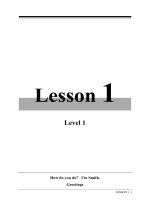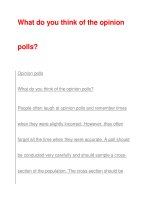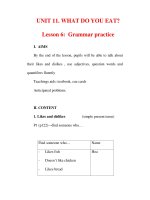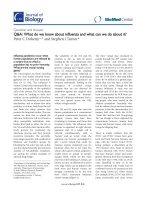14714 reading 1 what do you know about giant pandas
Bạn đang xem bản rút gọn của tài liệu. Xem và tải ngay bản đầy đủ của tài liệu tại đây (207.65 KB, 5 trang )
What do you know about giant
pandas? Read and complete the
article to find out more about
these cuddly black and white
bears. Circle the correct words.
Underline words you don’t
know.
Introduction
The giant panda has a distinctive (a) black/ (b) white head
with (a) black/ (b) white eye patches, ears and shoulders.
Unlike other bear species, giant pandas are (a)
carnivorous/ (b) herbivorous spending up to 12 hours a day chewing bamboo shoots and
roots. Because of poaching and habitat loss, they are extremely (a) common/ (b)
extinct/ (c) rare, occurring in small populations in the bamboo forests of China. Despite
being the subject of major international conservation efforts, wild populations of giant
pandas (a) can/ (b) may/ (c) must not be enough to save this species.
Panda’s Territory: Where do pandas come from?
Giant pandas (a) live/ (b) are living/ (c) have lived in the bamboo forests of China for
millions years and have been honored by the Chinese for a very long time. In fact, giant
pandas (a) appear/ (b) are appearing/ (c) have appeared in Chinese art for thousands
of years. Because the giant panda is considered a national treasure in China, it is
protected by law so that it (a) becomes/ (b) becomes not/ (c) does not
become extinct.
Although giant pandas have long been known to the
Chinese, they (a) are/ (b) do/ (c) have a recent
discovery for people living outside of China. The first
westerner to observe a live giant panda in the wild (a)
is/ (b) was/ (c) had been a German zoologist named
Hugo Weigold. In 1916, he (a) bought/ (b) has
bought/ (c) had bought a cub while he was on
expedition.
At Panda’s Place: Where do pandas live?
There is only one place where giant pandas (a) live/ (b) lived/ (c) were living in the wild:
high in the mountains of central China. There, they (a) live/ (b) are living/ (c) have
lived in cold and rainy bamboo forests that are often misty and shrouded in heavy clouds.
Once upon a time, giant pandas (a) lived/ (b) have lived/ (c) had lived in lowland areas.
However, as people (a) builded/ (b) built/ (c) had built more and more farms and cities
on that land, the giant pandas were forced up into the mountains. Today, they (a) live/
(b) lived/ (c) have lived at elevations of 5,000 to 10,000 feet.
Panda's Lunch: What do pandas eat?
In the wild, a giant panda’s diet is 99% bamboo.
Bamboo is a giant grass that (a) grows/ (b) is
growing/ (c) has grown in the mountains of China.
Because bamboo is so low in nutrients, an adult giant
panda (a) eats/ (b) is eating/ (c) has eaten between
20 and 40 or more pounds of it each day. It eats the
stems, shoots, leaves and all.
There are about 25 different types of bamboo that
wild pandas will eat. Some nutritionists (a) think/ (b)
are thinking/ (c) have thought that giant pandas need to eat not only different parts
of the bamboo, but also different kinds of bamboo in order to get proper nutrition. In
addition to bamboo, giant pandas (a) ate/ (b) eat/ (c) have eaten other grasses,
insects and occasionally, small rodents.
In zoos, giant pandas eat bamboo too, but they (a) have/ (b) may/ (c) would also eat
sugar cane, rice gruel, carrots, apples and sweet potatoes.
Panda Cubs: How are baby pandas born?
(a) If/ (b) while/ (c) when a giant panda is first born, it is tiny.
It (a) measures/ (b) tallies/ (c) weighs between four and six
ounces and is about the size of a stick of butter. At birth, it is pink,
blind, helpless and hairless. During this time, the mother cares for it
closely, often cradling it in her paw and keeping it close to her chest.
The cub (a) opens/ (b) doesn’t open/ (c) opens not its eyes until it
is six week old and it (a) walks/ (b) doesn’t walk/ (c) walks not until
it is three months.
Cubs nurse for about nine months but they stay with their mothers
for a long time after that. In fact, it (a) can/ (b) must/ (c)
should be up to three years before a giant panda cub strikes out on its own.
Panda’s Day Out: How does a panda spend the day?
In the wild, giant pandas (a) spend/ (b) are spending/ (c) have
spent most of their time resting, eating or looking for food. Unlike
other bear species, giant pandas do not hibernate during the winter
months. They also (a) build/ (b) do not build/ (c) have not
built permanent dens. Instead, they shelter in caves and trees.
Pandas are good climbers. They (a) can/ (b) could/ (c) should also swim, though they
spend most of their time on land. Although they might seem pretty quiet, giant
pandas (a) are/ (b) do/ (c) have make a lot of growling and honking sounds.
Pandas in Peril: Why are pandas endangered?
Today, giant pandas (a) are/ (b) have been/ (c) will be at risk of becoming extinct.
Only about 1,000 giant pandas are left in the wild. All of these (a) inhabit/ (b) are
inhabiting/ (c) have inhabited a small area in the bamboo forests of China. About 150
live in captivity. This is why the giant panda (a) listed/ (b) has listed/ (c) is listed as
endangered in the World Conservation Union's Red List of Threatened Animals. It is one
of the most severely (a) dangerous/ (b) endangered/ (c) extinct species in the world.
Pandas in Pounds: How big are pandas?
Giant pandas are about the size of an American black bear. When they (a) are standing/
(b) stood/ (c) have been standing on all four legs, giant pandas are two to three feet
tall at the shoulder. They can be up to six feet long. Males (a) are/ (b) have been/ (c)
will be usually larger than females. Males can weigh 250 pounds or more in the wild.
Females usually (a) grow/ (b) measure/ (c) weigh less than 220 pounds.
Pandas' Political Importance: What do pandas symbolize?
In China, people (a) believe/ (b) have believed/ (c) had believed for thousands years
that pandas are special. It is said that ancient emperors of China (a) kept/ (b) have
kept/ (c) had kept giant pandas as pets. Chinese books over two thousand years old
show giant pandas with mystical powers. People (a) think/ (b) thought/ (c) were
thinking that they (a) can/ (b) could/ (c) are able to ward off evil spirits and natural
disasters. Today, pandas (a) believe/ (b) are believed/ (c) have been believed to be a
symbol of peace and good fortune.
I beg your panda?
The 6th Finger: The giant panda has five fingers plus a "thumb," which isn't a real
thumb but a modified bone that (a) allow/ (b) allows/ (c) has allowed the panda to
grasp bamboo.
Docile or dangerous? Typically thought of as docile and harmless, the giant panda can be
as dangerous as any other bear when provoked and (a) has been known/ (b) was known/
(c) will have been known to attack humans on occasion.
Fast Facts
Type: Mammal
Diet: Bamboo shoots and roots
Average life span in the wild: 20 years
Size: 4 to 5 ft (1.2 to 1.5 m)
Weight: 300 lbs (136 kg)
Protection status: Endangered
Major Threats: Habitat loss, poaching and human encroachment
Habitat: Mountainous regions where bamboo is present
Location: Central China
Size relative to a 6-ft (1.8m) man: (see picture)
Answer Key
1.
2.
3.
4.
5.
6.
7.
8.
9.
10.
11.
12.
13.
14.
15.
16.
17.
18.
19.
20.
21.
22.
23.
24.
25.
26.
27.
28.
29.
30.
31.
32.
33.
34.
35.
36.
37.
(b) white head
(a) black eye patches
(b) herbivorous
(c) rare
(b) may
(a) live
(c) have appeared
(c) does not become
(a) are
(b) was
(a) bought
(a) live
(a) live
(a) lived
(b) built
(a) live
(a) grows
(a) eats
(a) think
(b) eat
(b) may
(c) when
(c) weighs
(b) doesn’t open
(b) doesn’t walk
(a) can
(a) spend
(a) build
(a) can
(b) do
(a) are
(a) inhabit
(c) is listed
(b) endangered
(a) are standing
(a) are
(c) weigh
38.
39.
40.
41.
42.
43.
44.
(b) have believed
(a) kept
(b) thought
(b) could
(b) are believed
(b) allows
(a) has been known









